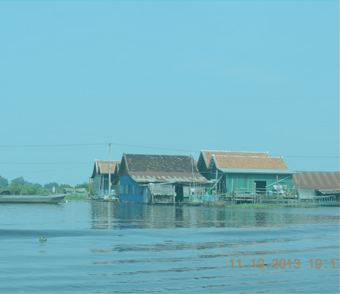Nearly half of the world’s rivers have been fragmented and transformed by at least one of the approximately 49,000 major dams operating across the globe. That number is growing as places like China, Cambodia, Laos, India, Brazil and many countries in Africa are planning or now constructing new dams to provide power, water, flood control and navigation for their growing populations. With few exceptions, these dams have not been sited, designed or operated to maintain downstream ecosystem functions. Yet, river-dependent ecosystem services, food production and livelihoods depend on the dynamic flows of water, sediment and nutrients. Excessive changes in any one of these variables can lead to the collapse of entire fisheries and ecosystems. The consequences for the downstream river system and human livelihoods can be profound.
By altering and depleting the natural flow regime, dams often:
-
-
- Transform highly dynamic riverine systems into static water delivery channels, reducing the diversity of habitat and species;
- Eliminate annual floods, depriving riparian forest and wetlands of periodic inundation;
- Effectively disconnect the river from its productive floodplain habitats making it impossible to use the floodplain as a source for natural and cultivated flood or even grazing;
- Trap the sediments and nutrients needed to nourish floodplain, wetland, delta and ocean foodwebs and ecosystems;
- Diminish seasonal inflows of freshwater, sediment and nutrients into the ocean, disrupting the estuarine hydrodynamics that are the engine for the exceptional biological fertility at the freshwater/salt water interface; and
- Cause native fisheries to suffer while providing new habitat for exotic invaders.
-
Through the Natural Heritage Institute’s Global Dam Reoperation Initiative (GDRI), NHI and its many local partner are developing and implementing reoperation plans (and in some cases, new designs) for major dams, and entire river basins, to restore a substantial measure of the natural productivity of rivers and their floodplains, wetlands, deltas and estuaries that have been impaired by dams. In many cases these changes do not significantly reduce – and can sometimes even enhance – the irrigation, power generation, and flood control benefits for which the dams were constructed. We are demonstrating a “toolkit” of improved water management techniques can provide the targeted major dams with the flexibility in reservoir storage and release patterns necessary to reestablish environmental flow regimes.
The GDRI Water Management Techniques include:
-
-
- Reoperating irrigation reservoirs in conjunction with groundwater banks to generate surplus water supply and increase the flexibility in storage and release patterns to enable environmental flows to be re-established;
-
- Changing the role that hydropower dams play in the mix of generators serving an electrical grid so that the dam can operate on a run-of-the-river basis – storing and releasing water in rhythm with inflow patterns rather than electricity demand patterns; and
-
- Alleviating floodplain development constraints to allow a seasonal pattern of controlled flood events to reconnect the river to its floodplain for both transitory flood storage and major ecosystem benefits.
-
- Reoperating the entire water management system – not just the storage component.
-
- Adapting to hydrologic perturbations associated with climate change
-
Read more about this topic in a book chapter by NHI’s Executive Director, Gregory A. Thomas, which can be found in a recent Elsevier publication edited by Horne, Webb, Stewardson, Richter and Acreman entitled WATER FOR THE ENVIRONMENT: FROM POLICY AND SCIENCE THROUGH TO IMPLEMENTATION. Mr. Thomas’s chapter (#21) on managing infrastructure to maintain natural flows in developed rivers, together with analytical tools for assessing the design and operation of major infrastructure projects for environmental sustainability, is available from NHI upon request to gat@n-h-i.org for educational use only. The entire book (Paperback ISBN: 9780128039076) may be ordered Elsevier.

